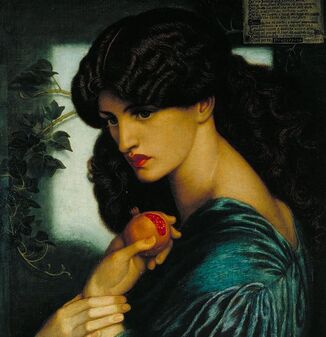|
I’ve always taken an interest in the names given to fairies in folklore and literature. Frequently the most famous fairies are kings and queens, like Oberon, Titania and Mab of Shakespeare. One name that was frequently given to a fairy queen at a certain point, but doesn’t get used as much anymore in pop culture, is Proserpina. The Roman goddess of the Underworld and equivalent of the Greek Persephone was recast as a fairy queen. There's a general trend of gods being downgraded to fairies across history. We see something similar with the goddess Diana’s name attributed in medieval times to pretty much any legend of nightly witch rides. In Dr. Samuel Harsenet's Declaration of egregious Popish Impostures (1603), the god Mercury is "Prince of the Fairies" as well as Jupiter's son. I want to delve into the idea of Proserpina as a fairy.
In Geoffrey Chaucer’s “The Merchant’s Tale” (The Canterbury Tales, dated 1387-1400), Pluto and Proserpine show up as the rulers of the fairies, hanging out in a garden. It's been suggested that these characters set the model for Shakespeare’s Oberon and Titania. In both works, the fairies are deity-like beings who take an interest in human love affairs and may sometimes magically interfere, and there's a focus on a disagreement between the fairy rulers. This might even have been the spark for later writers to use Proserpine as the fairy queen's name (Green p. 202). “Proserpyne” or “Proserpyna” is the benevolent fairy queen who guides the hero of The History of The Valiant Knight Arthur of Little Britain, with English translations dating to the mid-1500s. It originally came from French and goes back even further. In this story, there are actually four fairy queens, and she's their chief. Her role includes fairy godmother, fairy lover, supernatural helper and tutelary spirit motifs; blessing newborns, aiding the hero (flirting with him and then setting him up with her human doppelganger Florence), even pulling some changeling-style antics to take a woman's place (although she does it to help). Fairy queen Proserpina shows up in Thomas Campion’s poem Hark, All You Ladies (1591). Here she is a kind of love- and fertility-related spirit and leader of a troop of fairies who, in classic fashion, pinch people black and blue. And in RIchard Johnson’s The Most Famous History of the Seven Champions of Christendome (1596), Proserpine is a fairy queen who rules in the underworld and whose fairies lead human travelers astray. She also aids in childbirth and foretells children's futures - a very fairy godmother/Greek Fates thing to do. Proserpina did show up in her more goddess-like roles in literature. For instance, in Edmund Spenser's The Faerie Queene (1590-1956), she and Pluto are mentioned in a more negative light as the rulers of Hell and parents of the villainess Lucifera. But it seems like, for a small space here, we have a spate of stories where this Roman goddess simply is the fairy queen (and, with her, Pluto is the fairy king). In many ways this makes sense. Fairies are often tied to death and the afterlife in folk belief, and live in subterranean realms. In many cases, fairies actually are the dead. Proserpine/Persephone does hit on a lot of these trends, plus she's associated with nature and the seasons. But Proserpina was quickly overshadowed by Shakespeare's fairy queens, Titania and Mab. Especially Mab. She absolutely trounced Titania in the popularity department, stealing top billing as empress of all the fairies and also stealing Titania's husband Oberon. This was the time of tiny, comedic fairies being popular. A Midsummer Night's Dream's Titania was a seasonal goddess; Romeo and Juliet's Mab was a comedic mite tailor-made for the fashion of literary fairies. Proserpina, like Titania, just doesn't fit that mold. A more fitting role for her is seen in Michael Drayton’s Nymphidia (1627), where fairy ruler Queen Mab appeals to her as the "Queen of Shades" for witchy magical help. Just as there are many reasons why Proserpina would fit, there are also plenty of reasons this one didn't stick. Proserpina is clearly an outside influence, a famous Roman goddess, a foreign name slapped onto an ostensibly local story of fairies. Even Titania's name originally comes from Ovid's Metamorphoses. Mab, an English nickname, may have felt more natural and local. Or maybe people intentionally wanted to move away from Proserpina's darker associations of death, witchcraft and pagan religion (Nichols 404). Fairies were being sanitized. They were cute and funny. In more heroic, less comedic plays and poems, they were often used as metaphors for the royal family. All in all, it makes sense why this worked out like it did, but I also think Proserpine deserves a little more attention as a somewhat popular fairy queen character. Although her appearances are literary, many of them show hints of contemporary fairy beliefs. Sources
Blog posts
1 Comment
|
About
Researching folktales and fairies, with a focus on common tale types. Archives
July 2024
Categories
All
|
Writing in Margins

 RSS Feed
RSS Feed
